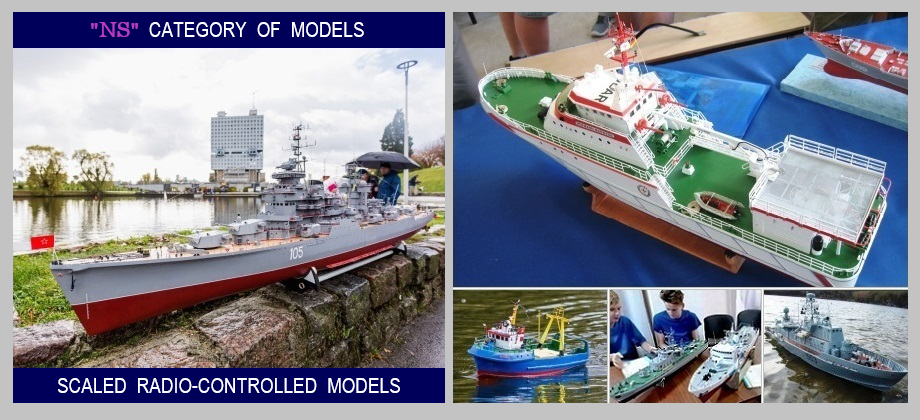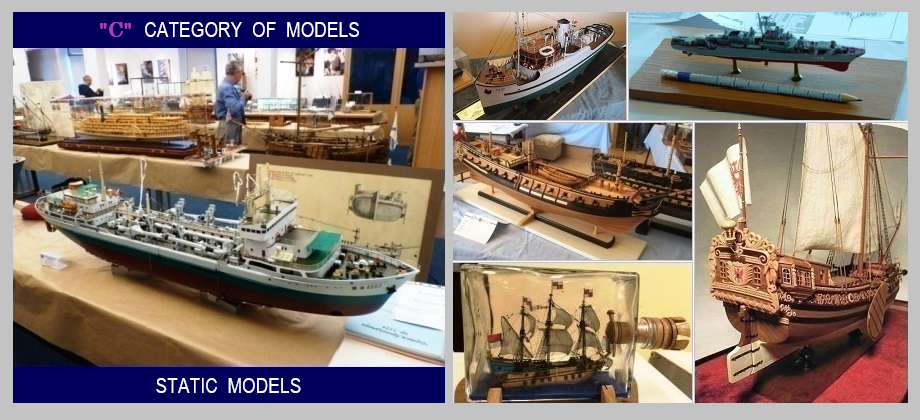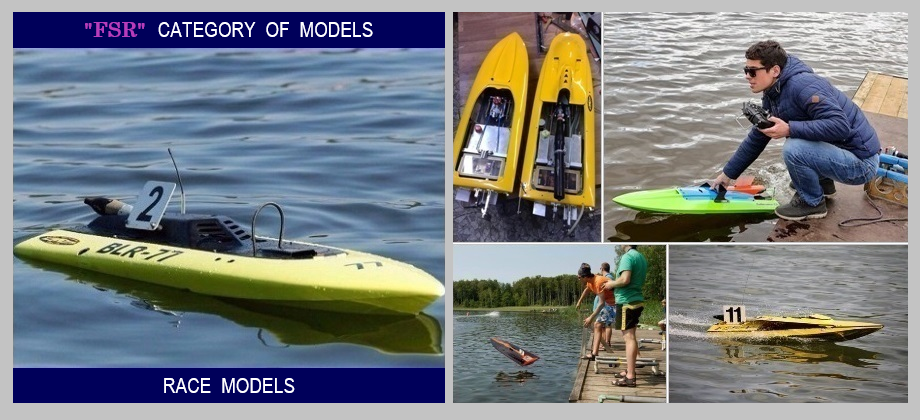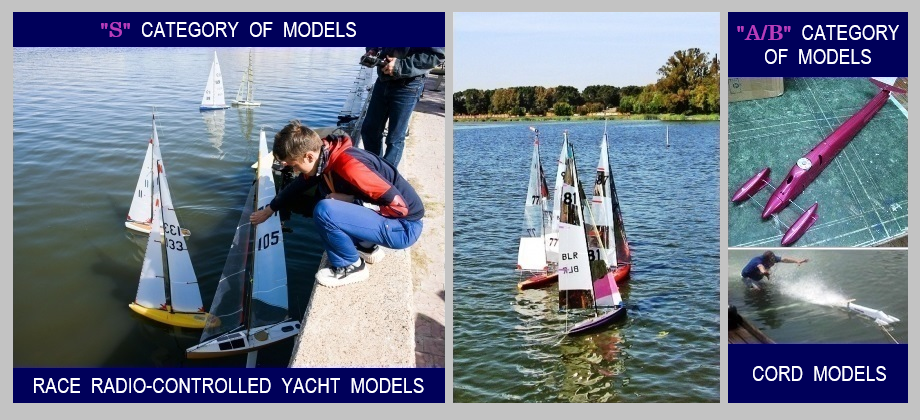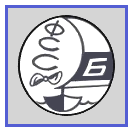► OUR MISSION IS UNITING PEOPLE TO ACTIVELY DEVELOP ALL AREAS OF SHIPMODELING SPORT TOGETHER !
Sports models of ships and boats are subdivided into categories; each category includes a number of disciplines (classes) of models. Models are differentiated depending on their type, tasks performed at the competitions, their engine type or capacity. This distinction is clearly reflected in the names of classes. SMSIF Rules document the way names of classes should be written and abridged.
Categories of sports models:
- NS – scaled radio-controlled models;
- C – static models;
- M – speed models;
- FSR – racing models;
- S – racing radio-controlled models of yachts;
- A/B – cord models.
Now let us define each of the above-mentioned categories.
..............................................................................................................................................................
NS Category – scaled radio-controlled models
NS Category includes radio-controlled scale models, that means, models of ships and vessels able to keep afloat and move on water and/or underwater. At the competition, participants should propel their models remotely, using wireless technology. These models are constructed according to the plan of their prototype ships in a chosen scale.
F2 Disciplines (Classes) are scale models of ships and boats which are constructed according to the ship plan and whose technical documentation confirms that they are made without any prefabricated materials and parts.
- F2-А – scale models-copies, not more than 900mm long;
- F2-B – scale models-copies whose length ranges from 900 to 1400mm;
- F2-C – scale models-copies, more than 1400mm long;
- F2-S – scale models-copies of submarines and other self-propelled vehicles.
F4 Disciplines (Classes).This category comprises models made from commercially available plastic kits. Models should look complete and have main distinctive elements and features of the ship.
- F4-А – plastic kit models with distinctive elements and features of the ship; ready industrially made models (RTR “ready to run,” ARTR “almost ready to run”.) Models of this category only undergo steering evaluation.
- F4-B – models made from commercially available kits, except for injection plastic kits. Models from this category undergo both static and steering evaluation. It is permitted to use other materials for amending and improving the outlook of the model; still, the hull and main elements should be taken from the kit.
- F4-C – injection plastic kit models, which undergo both static and steering evaluation. It is permitted to use other materials for amending and improving the outlook of the model; still, the hull and main elements should be taken from the kit.
- F6/F7 – precise and approximated functional models-copies of ships, boats and various vessels which are take part in team (F6) and personal (F7) performances. This category also includes various appliances directly related to a certain vessel type (for instance, floating cranes, floating drilling rigs, dockyard cargo machinery, draggers etc.) The evaluation focuses on the realization of functions performed by the prototype ship.
- F-DS – precise and close-to-prototype steamship models which are set into motion with a propeller, side or rear paddle wheel. The model should be driven only by means of its steam engine (with one or several cylinders) or a steam turbine. It is allowed to use auxiliary electric launch units for single cylinder or expansion machines to overcome a dead point.
NSS Disciplines (Classes) are precise and approximated sailing ship models constructed in any chosen scale. The static evaluation of these models focuses on the precision of their construction (how true to their prototype these models are).
- NSS-A – models with fore-and-aft/Bermudan sails, also with a wishbone gaff;
- NSS-B – models with fore-and-aft, gaff and lugger rigging (without square sails);
- NSS-C – models with square sails and other types of rigging (e.g., with lateen sails);
- NSS-D – multi-hull models and models with special propulsion units.
NSS models should be navigated wirelessly (using a radio channel). Using a gyrocompass in NSS Сlasses is allowed if only for special functions (i.e., to shift internal ballast depending on the tilt). It is prohibited to use the gyrocompass for model navigation/control.
All classes of models belonging to NS category undergo static evaluation (except for F4-A Сlass).
The competition aim is to obtain the highest score according to the established criteria. This score is the sum of static evaluation result and the course (steering) evaluation result. The latter is the median value of two best attempts on the set water course (out of three).
C Category - static models
C Category includes radio-controlled scale models of ships and vessels constructed in a certain scale, also series of models, dioramas, cross-sections, technical appliances, units and parts of ships.
C Category comprises the following disciplines (classes):
- С-1 – models of rowboats and sailing ships;
- С-2 – models of ships with mechanical propulsion;
- С-3 А/В/С – cross-section models, admiralty and half hull models, models of port equipment, docks, flood gates, lighthouses and dockyards, dioramas (scale up to 1:250), series of models (at least 3), models of parts, units and details of ships;
- С-4 А/В/С – miniature boats analogous to C1-C3 classes, constructed in scale 1:250 and under, including dioramas. Series of models, hydrotechnical and navigation facilities (at least 3 models). Cross-sections, fragments, parts of ships;
- С-5 – models in bottles;
- С-6 А/В/С – plastic models (from injection plastic and resin kits);
- С-7 А/В – models from industrial paper and cardboard kits;
- С-8 А/В – models from wooden and combined kits.
The competition aim is to obtain the highest static evaluation result according to the established criteria. The highest score given by the judges’ commission is 100 points.
M Category - speed models
M Category models are freely constructed radio-controlled speed models fitted with electric or internal combustion engines (further on-ICE) according to their class specifications.
F1 and F3 Disciplines (Classes) comprise freely constructed radio-controlled speed models driven with a fully submerged propeller.
In F1 Сlasses, the winner is the model which it took the least time to cover the distance set by the competition rules.
- F1-V 3.5 speed boats are freely constructed ICE models, with working cylinder capacity of 3.5 cm3.
- F1-V 15 speed boats are freely constructed ICE models, working cylinder capacity ranges from 3.5 to 15 cm3.
F1-V models may be fitted with any number of engines but their total cylinder capacity should not exceed the limits set for each class. - F1-E speed boats are freely constructed models fitted with an electric engine. No limits are set upon their weight. Their battery voltage should not exceed 42.3 V. The maximum weight of Lipo batteries should not be more than 1400 g. Batteries of other types have no weight limits.
The competition aim in F3 Сlasses is to find which model covers the distance set in the competition rules in minimal time and as precisely as posible.
- F3-V speed boats are freely constructed ICE models;
- F3-E speed boats are freely constructed models fitted with an electric engine. No limits are set upon their weight. Battery requirements are the same as for F1-E Class.
ECO Disciplines (Classes) are freely constructed radio-controlled racing boats fitted with an electric engine and driven with a fully submerged propeller. The competition aim is to cover the largest possible number of laps during the race course set in the competition rules.
- ECO Expert. The minimal weight of the model is 1 kg (when ready to start). The race time is 6 min; 3 to 6 models may compete in the race.
- ECO Expert-mini. These models differ from ECO Expert models by the following standards: the minimal weight of the model is 450 g (when ready to start), the length should not be over 430 mm.
- ECO Start. These models are designed for racing in swimming pools and water bodies where it is impossible to set a course according to ECO Expert-mini specifications. Similar to ECO Expert-mini, the minimal weight of the model is 450 g (when ready to start), the length should not be over 430 mm, the race time is 6 min.
- ECO Standard. Their class definition, construction norms and requirements, competition rules are the same as in ECO Expert. The race time is 10 min.
- ECO “TEAM” is a relay team race for ECO Expert and ECO Standard models. Each team consists of 2 or 3 competitors.
- ECO “TEAM-MINI” is a relay team race for ECO Expert-mini models.
FSR-E Discipline (Class) are freely constructed monohull radio-controlled racing boats fitted with an electric engine and driven with a fully submerged propeller. The race time is 15 min, 3 to 8 models take part in one race.
M1 Mono, M2 Mono, Mono-mini Disciplines (Classes) are monohull models with a semi-submerged propeller. Mono class models should be styled close to their prototype. 3 to 6 models take part in a race.
Hydro H1, Hydro H2, Hydro-mini Disciplines (Classes) are multi-hull three point boats or catamarans with semi-submerged propellers. 3 to 6 models take part in a race.
Mono-mini and Hydro-mini models should not be over 450 mm long. The weight should be not less than 450 g (when ready to start). Both the length and weight of the model are checked before the start.
FSR Category – racing boats
FSR-V Disciplines include monohull radio-controlled freely-constructed racing boats, fitted with an ICE and driven with a fully submerged propeller or several prolellers which should be placed below the keel line. These models participate in group racing and the competitors have to control and adjust the direction and speed of models during the race. 3 to 12 models may take part in the race. The competition aim is to cover the largest possible number of laps during the race course.
- FSR-V-3.5 – models fitted with an ICE with working capacity up to 3.5 cm3;
- FSR-V-7.5 – models fitted with an ICE with working capacity from 3.5 to 7.5 cm3;
- FSR-V-15 – models fitted with an ICE with working capacity from 7.5 to 15 cm3;
- FSR-V-27 – models fitted with a petrol spark-ignition ICE with working capacity from 15 to 27 cm3;
- FSR-V-35 – models fitted with a petrol spark-ignition ICE with working capacity from 27 to 35 cm3.
FSR-H Disciplines comprise classes of radio-controlled freely-constructed models with two or more sliding surfaces (further on – hydroplanes), fitted with an ICE and driven with a partially submerged propeller (propellers). These models participate in group racing and the competitors have to control and adjust the direction and speed of models during the race. 4 to 8 models take part in the race. The aim of FSR-H competition is to run 6 laps of a certain course in minimal time possible.
- FSR-H-3.5 – hydroplanes fitted with an ICE with working capacity up to 3.5 cm3;
- FSR-H-7.5 – hydroplanes fitted with an ICE with working capacity from 3.5 to 7.5 cm3;
- FSR-H-15 – hydroplanes fitted with an ICE with working capacity from 7.5 to 15 cm3;
- FSR-H-27 – hydroplanes fitted with a petrol spark-ignition ICE with working capacity from 15 to 27 cm3.
FSR-O disciplines comprise classes of radio-controlled freely-constructed monohull models, fitted with an ICE and driven with a partially submerged propeller (propellers) whose axis lines should be above the keel line of the model. These models participate in group racing and the competitors have to control and adjust the direction and speed of models during the race. 3 to 10 models take part in the race. The race time is 8 or 12 min. The aim of FSR-O competition is to run as many laps as possible during the race course.
- FSR-O-3.5 – models fitted with an ICE with working capacity up to 3.5 cm3;
- FSR-O-7.5 – models fitted with an ICE with working capacity from 3.5 to 7.5 cm3;
- FSR-O-15 – models fitted with an ICE with working capacity from 7.5 to 15 cm3;
- FSR-O-27 – models fitted with a gasoline spark-ignition ICE with working capacity from 15 to 27cm3;
- FSR-O-35 – models fitted with a petrol spark-ignition ICE with working capacity from 27 to 35 cm3.
S Category – racing radio-controlled yacht models
S Category yacht models are sailing models whose propulsion requires just natural wind power received by sails, hull, spars and other parts of the yacht. The competitor only adjusts the sails and the rudder using radio-control equipment.
S Category includes the following disciplines/classes:
- F5-M “Marblehead”
The international “Marblehead” class comprises yachts with limitations of hull length, sail area, ballast, sails rigging and spars elements. It is only allowed to use monohull yachts, total length (including bow fender) is not less than 1276 mm and not more than 1289 mm. Sails rigging of each set should not be more than one mainsail and one foresail.
- F5-10 “Tenrater”
This is a construction class where the length of the deep water line should be in inverse proportion to the sail area. Any masts are allowed (curved, rotating, with a spinnaker) and booms.
- F5-E “One meter”
In this discipline, the total hull length of the model (including bow fender) is 1000 mm. Multi-hull constructions are prohibited.
Any material is allowed for hull construction (except for carbon and aramid (Kevlar) fibres. The internal hull surface must be painted in such a way as to enable checking the hull material. Only a fixed mast is allowed, its maximum above deck height does not exceed 1700 mm. Sails rigging should include a mainsail and a foresail. Both sails should be based on triangular shape.
A/B Category – cord models
A speed cord model is a freely constructed model with its own buoyancy, fitted with an internal combustion engine (ICE) or an electric engine which starts the water or air propeller. The model is tethered to the cord mast with a cord metal thread and moves in a circle where the cord mast is in the center. The aim of the competition is to cover as many circles (base) as possible at the highest speed.
A/B Category includes the following disciplines/classes:
- A1 – speed cord model fitted with an ICE and set into motion with a water propeller. The working capacity of the engine is up to 3.5 cm3, model weight up to 1.2 kg and the exhaust port diameter is not more than 7.0 mm;
- A2 – speed cord model fitted with an ICE and set into motion with a water propeller. The working capacity of the engine is up to 7.5 cm3, model weight up to 2 kg and the exhaust port diameter is not more than 8.0 mm;
- А3 – speed cord model fitted with an ICE and set into motion with a water propeller. The working capacity of the engine is up to 10 cm3, model weight up to 2.5 kg and the exhaust port diameter is not more than 10.0 mm;
- В1 – speed cord model fitted with an ICE and set into motion with an air propeller. The working capacity of the engine is up to 2.5 cm3, model weight up to 0.75 kg and the exhaust port diameter is not more than 5.0 mm;
- A1E – speed cord model fitted with an electric engine and set into motion with a water propeller. The battery voltage is up to 42.3 V and model weight up to 1.2 kg;
- B1E – speed cord model fitted with an electric engine and set into motion with an air propeller. The battery voltage is up to 42.3 V and model weight up to 0.75 kg.
Speed cord models should possess their own buoyancy when their engines are disabled. Models in B1 and B1E classes should be constructed in such a way as to enable positioning the air propeller any way above water (when the model is set on water untethered).
